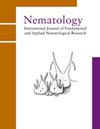Plant-parasitic nematodes, a looming threat to turmeric cultivation in India: results of recent surveys
IF 1.2
4区 生物学
Q2 ZOOLOGY
引用次数: 0
Abstract
Summary Turmeric ( Curcuma longa ) is a major spice of Indian origin. Turmeric is commonly used in Ayurvedic and Siddha medicine, and also in Indian cuisine. India produces nearly 1.2 million tonnes (Mt) of turmeric annually and is one of the world’s largest producers. Turmeric production is limited by a number of biotic and abiotic factors. Among the biotic factors, plant-parasitic nematodes (PPN) are important. They include Meloidogyne spp., Pratylenchus spp., Radopholus similis and Rotylenchulus reniformis . However, the information about the distribution, density and prominence of plant-parasitic nematodes and their interrelation with soil types is very scarce. Hence, the present comprehensive nematode survey was undertaken in the major turmeric-producing states of India: Tamil Nadu, Andhra Pradesh, Telangana and Odisha. The results indicated that Meloidogyne spp., R. reniformis , Pratylenchus spp., R. similis , Hoplolaimus spp., Helicotylenchus spp. and Tylenchorhynchus spp. were associated with turmeric. The most abundant nematodes were Meloidogyne spp. (115 individuals (100 cm 3 soil) −1 ), followed by R. reniformis (68 (100 cm 3 soil) −1 ) and Pratylenchus spp. (50 (100 cm 3 soil) −1 ). The frequency of occurrence ranged from 0 to 60%, with Meloidogyne spp. (60%) and R. reniformis (51%) being the most common. Meloidogyne spp. (38%) and Pratylenchus spp. (19%) were the most prominent nematodes in plant samples. Overall, Meloidogyne spp. followed by Pratylenchus spp., R. reniformis and R. similis were the key nematodes associated with the turmeric crop in all the four states. Further, we have identified hotspot areas for the plant-parasitic nematodes, namely: Meloidogyne spp. (16), Pratylenchus spp. (16), R. reniformis (20), and R. similis (5) on the basis of the economic threshold level. The interrelationship of soil type and nematode distribution was also investigated.植物寄生线虫,对印度姜黄种植迫在眉睫的威胁:最近调查的结果
姜黄(Curcuma longa)是一种主要的印度香料。姜黄通常用于阿育吠陀和悉达医学,也用于印度美食。印度每年生产近120万吨姜黄,是世界上最大的姜黄生产国之一。姜黄的生产受到许多生物和非生物因素的限制。在生物因子中,植物寄生线虫(PPN)是一个重要的因素。它们包括Meloidogyne、Pratylenchus、Radopholus similis和Rotylenchulus reniformis。然而,关于植物寄生线虫的分布、密度和显著性及其与土壤类型的相互关系的资料非常少。因此,目前的综合线虫调查是在印度主要的姜黄生产邦:泰米尔纳德邦、安得拉邦、特伦甘纳邦和奥里萨邦进行的。结果表明:姜黄与Meloidogyne、reniformis、Pratylenchus、similis、Hoplolaimus、Helicotylenchus和Tylenchorhynchus有亲缘关系。线虫数量最多的是Meloidogyne spp.(115个(100 cm 3土壤)−1),其次是R. reniformis(68个(100 cm 3土壤)−1)和Pratylenchus spp.(50个(100 cm 3土壤)−1)。发生频率在0 ~ 60%之间,以Meloidogyne spp.(60%)和r.r eniformis(51%)最为常见。在植物样本中最显著的线虫是Meloidogyne spp(38%)和Pratylenchus spp(19%)。总体而言,4个州与姜黄作物相关的关键线虫依次为Meloidogyne spp.、Pratylenchus spp.、reniformis r.s和similis r.s。此外,我们还根据经济阈值水平确定了植物寄生线虫的热点区域,即:Meloidogyne spp.(16)、Pratylenchus spp.(16)、R. reniformis(20)和R. similis(5)。研究了土壤类型与线虫分布的相互关系。
本文章由计算机程序翻译,如有差异,请以英文原文为准。
求助全文
约1分钟内获得全文
求助全文
来源期刊

Nematology
生物-动物学
CiteScore
2.60
自引率
33.30%
发文量
67
审稿时长
3 months
期刊介绍:
Nematology is an international journal for the publication of all aspects of nematological research (with the exception of vertebrate parasitology), from molecular biology to field studies. Papers on nematode parasites of arthropods, and on soil free-living nematodes, and on interactions of these and other organisms, are particularly welcome. Research on fresh water and marine nematodes is also considered when the observations are of more general interest.
Nematology publishes full research papers, short communications, Forum articles (which permit an author to express a view on current or fundamental subjects), perspectives on nematology, and reviews of books and other media.
 求助内容:
求助内容: 应助结果提醒方式:
应助结果提醒方式:


